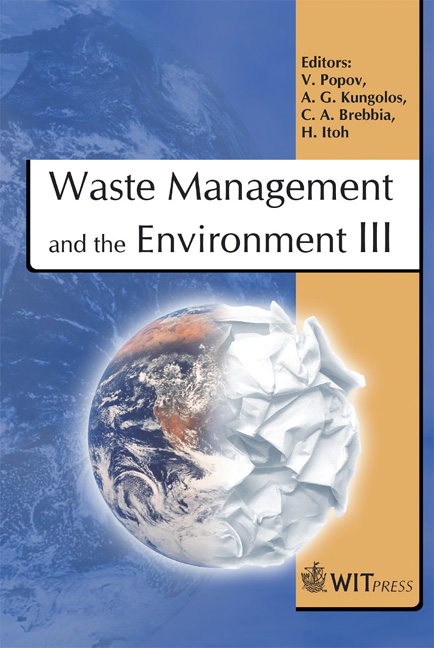Decomposition And Detoxification Of DXNs Adsorbed On Various Solid Wastes By Microwave Plasma Treatment
Price
Free (open access)
Transaction
Volume
92
Pages
8
Published
2006
Size
351 kb
Paper DOI
10.2495/WM060301
Copyright
WIT Press
Author(s)
R. Sasai, M. Jin-no, A. Satoh, Y. Imai & H. Itoh
Abstract
Microwave plasma treatment of the various solid wastes adsorbed with DXNs was investigated to develop an effective and novel method for in situ detoxification of DXNs in solid wastes such as incinerator fly ashes of the municipal wastes (IFA) or used activated carbons (AC). It was found that the microwave plasma treatment could completely decompose the adsorbed DXNs into inorganic gases such as Cl2, CO2 and CH4 with low plasma power (250 W) and short treatment time (< 15 min). Moreover, this decomposition behaviour did not depend on the kinds of solid wastes adsorbed with DXNs. In the case of IFA, the treatment time needed was slightly affected by the amount and/or chemical species of inorganic salt (CuO, CuCl2, Ca(OH)2, CaCl2, etc.) contained in the IFA at low plasma power region (< 100 W), but this change was negligible at higher plasma power (> 250 W). The AC obtained after the microwave plasma treatment exhibited almost the same characteristics of specific surface area, pore size distribution, and pore volume. Furthermore, the weight loss of AC due to burning and/or ablation could be scarcely observed. This shows that the microwave plasma can selectively decompose the organic species adsorbed on solid matter. Thus, the present microwave plasma treatment was found very useful not only as a decomposition method of the toxic organic compounds on solid, but also as a recycling method of the used inorganic solid adsorbents. Keywords: microwave plasma treatment, DXNs, incinerator fly ash, used activated carbon, detoxification, recycling.
Keywords
microwave plasma treatment, DXNs, incinerator fly ash, used activated carbon, detoxification, recycling.





